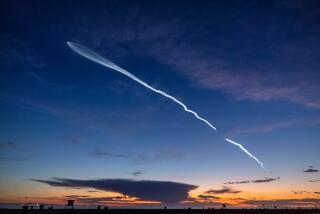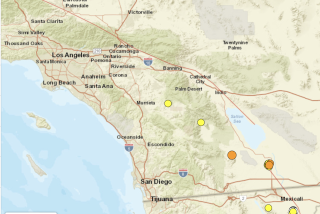SCIENCE : Sound and Fury Signifies the World Below Our Feet : Project Deep Probe uses explosions and ultrasound to draw map of the Earth’s mantle. Blasts set off from Canada to New Mexico.
RIVERTON, Wyo. — Before most in the American West had roused themselves one morning last week, five underground explosions jolted their very foundation.
While the blasts were imperceptible to anyone more than a few miles from ground zero, they emitted subterranean sound waves apparent to two 550-mile-long strings of seismographs running from Canada, through Montana and into central Wyoming.
It was an ultrasound exam of the Earth called Project Deep Probe. If all goes according to plan, it will be conducted again Thursday. By tracking the minuscule vibrations as they echo through the ground at roughly 5 miles per second and shake the sensitive seismographs, scientists hope to produce a sonar profile of the planet’s insides, as if they had sliced through the globe with a knife.
“We really don’t have a very good idea what’s down there, which leaves us with some puzzles about what we see on the surface,” said Randy Keller, a professor of geophysics at the University of Texas at El Paso and a leader of the joint U.S.-Canadian project.
Researchers aimed the explosions so that reverberations would sound out depths of 300 miles or more, three times deeper than such probing had ever gone before and deep enough to survey the Earth’s murky mantle. To cover such distances, the explosions were widely spaced, one as far north as Canada’s Northwest Territories and another 2,100 miles south in New Mexico. They were also powerful: The biggest released roughly as much energy as a 3.5 earthquake.
In central Wyoming, researchers detonated more than five tons of explosives under 160 feet of water at the bottom of an abandoned open-pit uranium mine.
A booming thump heralded geysers of water that shot into the air like fire hoses. Instantly, the ground rolled like the ocean as waves from the blast took off through the continent and toward the mantle far below.
If the Earth were an M&M; candy with a peanut inside, the hard candy shell would be the thin crust and the nut would be the fiery core. The layer of chocolate in between would represent the mantle, which makes up most of the planet’s innards and is the primary target of Deep Probe.
An invisible architect, the mantle holds the earthen machinery that propels plate tectonics, powers volcanoes and makes the Rocky Mountains rocky. Poking about, geologists figure that studying ancient mantle rock will teach them more about earthquakes and other pressures that shaped the continent.
There are practical spinoffs too. The Air Force has partly funded Deep Probe because military scientists must understand the framework of the Earth if they are to distinguish between the seismic rumblings of earthquakes and nuclear weapon tests. Miners are curious about deposits of diamonds, thought to form under great pressure within the mantle.
The only realistic way to probe the deep is to imitate oil exploration crews and eavesdrop on sound waves that zip through earth. Just as glasses holding various amounts of water ring differently when tapped with a spoon, rocks of different density, thickness and temperature alter sound waves, which then become messengers of the underground realms they billow through.
To gauge the telltale waves, scientists need to know where and when they will fan out. But earthquakes, the primary natural source of seismic swells, are notoriously unpredictable.
For the $1-million-plus Project Deep Probe, researchers created their own tremors by touching off explosives in the middle of the night.
“Waves that travel as far as we want them to are very faint, so we’ve really got to work to screen out all the other noise,” said Alan Levander, a professor of geophysics at Rice University and a leader of Deep Probe.
Nearly 100 scientists cast a giant net to catch faint signals from the faraway blasts. Equipped with four-wheel-drives and cellular telephones, they arranged nearly 800 seismographs, one every eight-tenths of a mile, over a 550-mile belt from southern Alberta to central Wyoming. Since timing is essential to an exact portrait of the blast waves, satellite-relayed time signals synchronized clocks in the detonation timers and the $15,000 seismographs within one one-hundredth of a second.
After the first set of five explosions last Wednesday, teams collected the shoe-box-sized instruments and found that they had registered the waves that rolled past. Scientists then replanted them along a new north-south corridor running farther south, into New Mexico, and were ready to touch off another round of explosions early Thursday.
They expect the two sets of blasts will give them two images, one of the geologically young foundation beneath Wyoming and Colorado and another of Alberta and Montana, where crystalline rocks beneath 2.5-billion-year-old sediment comprise the very basement of North America. Comparing the two, Ron Clowes, a professor of geophysics at the University of British Columbia said, should “finally let us put the story together about how this continent came to be.”
More to Read
Sign up for Essential California
The most important California stories and recommendations in your inbox every morning.
You may occasionally receive promotional content from the Los Angeles Times.










